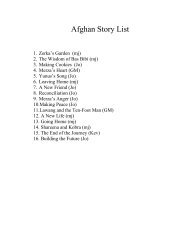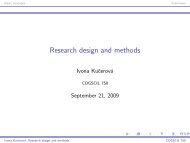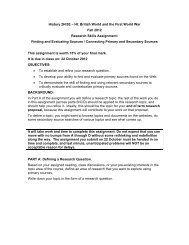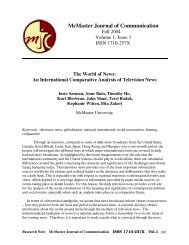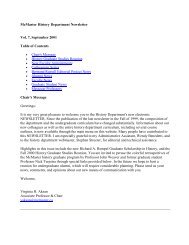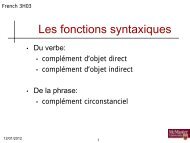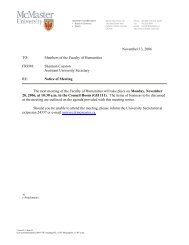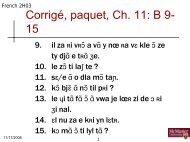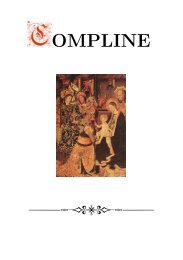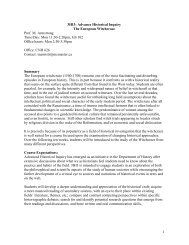2TT3 Survey of Canadian History, 1885 to the Present - McMaster ...
2TT3 Survey of Canadian History, 1885 to the Present - McMaster ...
2TT3 Survey of Canadian History, 1885 to the Present - McMaster ...
You also want an ePaper? Increase the reach of your titles
YUMPU automatically turns print PDFs into web optimized ePapers that Google loves.
Course Overview<br />
HISTORY <strong>2TT3</strong>E<br />
CANADIAN HISTORY SINCE <strong>1885</strong><br />
Instruc<strong>to</strong>r: Dr. Neil White<br />
Lectures: Monday 7:00 – 9:00 pm JHE 376<br />
Email: whitent@mcmaster.ca<br />
Phone: 905-525-9140 ext. 24136<br />
Office Hours: Monday 3:30-5:00 pm<br />
Room: CNH 603<br />
<strong>2TT3</strong>E surveys <strong>Canadian</strong> his<strong>to</strong>ry since <strong>1885</strong> on a number <strong>of</strong> levels. I will begin<br />
with a summary <strong>of</strong> Canada’s immediate post-confederation his<strong>to</strong>ry. I will <strong>the</strong>n cover<br />
early <strong>Canadian</strong> economics, politics, and society; <strong>the</strong> impact <strong>of</strong> World War I; <strong>the</strong> Great<br />
Depression and World War II; Newfoundland’s late entrance in<strong>to</strong> Confederation; <strong>the</strong><br />
evolution <strong>of</strong> <strong>the</strong> <strong>Canadian</strong> welfare state; <strong>to</strong> some observations on how <strong>Canadian</strong>s have<br />
grappled with more contemporary issues like environmental protection and globalization.<br />
Along <strong>the</strong> way, guest lecturers will provide more specific case studies linked <strong>to</strong> <strong>the</strong><br />
bigger issues I discussed. I intend <strong>to</strong> focus throughout <strong>the</strong> course on <strong>the</strong> ways <strong>Canadian</strong>s<br />
have shaped <strong>the</strong>ir identities in response <strong>to</strong> wider social, economic and political trends.<br />
This course rejects <strong>the</strong> idea <strong>of</strong> a single <strong>Canadian</strong> s<strong>to</strong>ry. A his<strong>to</strong>ry <strong>of</strong> <strong>Canadian</strong><br />
society that incorporates ethnic, religious, gender, and class relations qualifies <strong>the</strong> idea <strong>of</strong><br />
a single national his<strong>to</strong>ry by showing that <strong>Canadian</strong>s have been divided internally on an<br />
array <strong>of</strong> issues from <strong>the</strong> execution <strong>of</strong> Louis Riel <strong>to</strong> ongoing debates on <strong>the</strong> federalprovincial<br />
balance <strong>of</strong> power and native land rights. Canada has been and continues <strong>to</strong> be<br />
a nation comprised <strong>of</strong> peoples with various and <strong>of</strong>ten competing identities; a nation<br />
searching for a national character. Grounding case studies in a wider political, economic,<br />
and social context enriches broad and narrow views <strong>of</strong> Canada’s his<strong>to</strong>rical development.<br />
<strong>2TT3</strong>E will lead students <strong>to</strong> a complex and more comprehensive understanding <strong>of</strong><br />
<strong>Canadian</strong> his<strong>to</strong>ry since <strong>1885</strong>.<br />
Course Texts<br />
Ei<strong>the</strong>r:<br />
J. M. Bumsted, A <strong>His<strong>to</strong>ry</strong> <strong>of</strong> <strong>the</strong> <strong>Canadian</strong> Peoples, 3 rd Edition. Don Mills: Oxford<br />
University Press, 2007.<br />
Or:<br />
J. M. Bumsted, The Peoples <strong>of</strong> Canada: A Post-Confederation <strong>His<strong>to</strong>ry</strong>, 2 nd Edition. Don<br />
Mills: Oxford University Press, 2004.<br />
<strong>His<strong>to</strong>ry</strong> <strong>2TT3</strong>E Cus<strong>to</strong>m Courseware<br />
1
Note: Those <strong>of</strong> you who <strong>to</strong>ok <strong>Canadian</strong> <strong>His<strong>to</strong>ry</strong> with Dr. Cruikshank last term will<br />
already own A <strong>His<strong>to</strong>ry</strong> <strong>of</strong> <strong>the</strong> <strong>Canadian</strong> Peoples. The o<strong>the</strong>r text, The Peoples <strong>of</strong> Canada,<br />
goes in<strong>to</strong> post-Confederation his<strong>to</strong>ry in greater detail. You have <strong>the</strong> option <strong>of</strong> using<br />
ei<strong>the</strong>r, but I have ordered only copies <strong>of</strong> A <strong>His<strong>to</strong>ry</strong> <strong>of</strong> <strong>the</strong> <strong>Canadian</strong> Peoples at Titles<br />
Books<strong>to</strong>re. I have listed readings for each week as sections from A <strong>His<strong>to</strong>ry</strong> <strong>of</strong> <strong>the</strong><br />
<strong>Canadian</strong> Peoples OR from The Peoples <strong>of</strong> Canada. Ei<strong>the</strong>r is okay.<br />
Evaluation<br />
Tu<strong>to</strong>rial Participation 20%<br />
Article Review (Due 28 January) 10%<br />
Essay Outline and Annotated<br />
Bibliography (Due 11 February) 10%<br />
Research Essay (Due 17 March) 30%<br />
Final Exam (TBA) 30%<br />
Participation (20%)<br />
Active and informed participation in <strong>the</strong> weekly tu<strong>to</strong>rials makes up twenty percent <strong>of</strong><br />
your course grade. More importantly, it provides a forum for you <strong>to</strong> shape and refine<br />
your own understanding <strong>of</strong> Canada’s past by engaging in a conversation with your peers<br />
and tu<strong>to</strong>rial leader.<br />
Tu<strong>to</strong>rials are your time. Lead <strong>the</strong> discussion <strong>to</strong>ward more contemporary issues, discuss<br />
how <strong>the</strong> current week’s <strong>to</strong>pics relate <strong>to</strong> o<strong>the</strong>r course <strong>the</strong>mes, raise a point that I may have<br />
overlooked, or discuss how <strong>the</strong> <strong>to</strong>pics relate <strong>to</strong> <strong>the</strong> wider practice <strong>of</strong> researching and<br />
writing his<strong>to</strong>ry. Just try <strong>to</strong> stay generally on <strong>to</strong>pic and treat everyone with respect.<br />
Your TA and I hold regular <strong>of</strong>fice hours. See us if you have questions or concerns.<br />
Review Essay (10%)<br />
Due 28 January / Week 4<br />
<strong>His<strong>to</strong>ry</strong> <strong>2TT3</strong>E is a Humanities course and you are expected <strong>to</strong> be able <strong>to</strong> convey your<br />
well-researched interpretations clearly and succinctly in analytical essays. The major<br />
assignment for this course is a 12-page research paper that uses at least six reliable<br />
secondary sources (See <strong>the</strong> Research Paper section and attached list <strong>of</strong> essay <strong>to</strong>pics). The<br />
major paper is worth 30%. It is a significant part <strong>of</strong> <strong>the</strong> course grade. The first two<br />
assignments are meant <strong>to</strong> build your interpretive, organizational, and essay writing skills<br />
<strong>to</strong> assist you with <strong>the</strong> major paper.<br />
2
First you will write a short review essay <strong>of</strong> ei<strong>the</strong>r Ian McKay, “Tartanism Triumphant:<br />
<strong>the</strong> Construction <strong>of</strong> Scottishness in Nova Scotia,” Acadiensis 21, 2 (1992): 5-47 OR<br />
Robert Cupido, “Appropriating <strong>the</strong> Past: Pageants, Politics, and <strong>the</strong> Diamond Jubilee <strong>of</strong><br />
Confederation,” Journal <strong>of</strong> <strong>the</strong> <strong>Canadian</strong> His<strong>to</strong>rical Association 9 (1998): 155-186. It<br />
will show your TA if you understand <strong>the</strong> course readings and give her or him a chance <strong>to</strong><br />
‘catch’ serious grammatical, stylistic, or interpretive errors before <strong>the</strong> research paper.<br />
The review should begin with a brief introduction <strong>to</strong> <strong>the</strong> author and his main points. Who<br />
is he and what is <strong>the</strong> article’s main focus? The first paragraph should end with a<br />
reasoned and fair assessment <strong>of</strong> <strong>the</strong> article’s value. Was it convincing and – briefly –<br />
why or why not? That is your <strong>the</strong>sis statement, <strong>the</strong> unifying argument that will lead your<br />
TA through <strong>the</strong> remainder <strong>of</strong> your review.<br />
In <strong>the</strong> body <strong>of</strong> your review, you should more fully describe <strong>the</strong> article’s <strong>the</strong>sis and<br />
specific <strong>the</strong>mes. Expand on your opening statement about <strong>the</strong> author’s main purpose and<br />
describe some <strong>of</strong> <strong>the</strong> evidence and examples <strong>the</strong> author uses. Then you should comment<br />
on <strong>the</strong> mechanics <strong>of</strong> <strong>the</strong> essay. Was its structure logical? As far as you know were <strong>the</strong><br />
author’s sources appropriate for <strong>the</strong> <strong>to</strong>pic?<br />
Next, critique and/or defend <strong>the</strong> article’s argument and content. Was <strong>the</strong> <strong>the</strong>sis<br />
convincing? Refer <strong>to</strong> specific examples in <strong>the</strong> essay and explain why or why not. How<br />
does it contribute <strong>to</strong> our understanding <strong>of</strong> <strong>Canadian</strong> his<strong>to</strong>ry? What does <strong>the</strong> article tell us<br />
about national and regional identities? Finally, sum up your review in a short concluding<br />
paragraph.<br />
Five <strong>to</strong> six double-spaced pages with a 12-point font and regular margins (1 inch <strong>to</strong>p and<br />
bot<strong>to</strong>m, 1.25 inches left and right). Those margins are usually <strong>the</strong> default settings for<br />
word processing programs.<br />
Please remember <strong>to</strong> keep copies <strong>of</strong> all <strong>of</strong> your assignments and your research notes.<br />
I may ask <strong>to</strong> see <strong>the</strong>m.<br />
Essay Outline and Annotated Bibliography (10%)<br />
Due 11 February / Week 6<br />
You will submit a working <strong>the</strong>sis statement, outline, and annotated bibliography on your<br />
chosen essay <strong>to</strong>pic (see <strong>the</strong> list <strong>of</strong> <strong>to</strong>pics below) five weeks before <strong>the</strong> finished research<br />
essay is due. You may do a <strong>to</strong>pic that is not on <strong>the</strong> list if your Teaching Assistant<br />
approves <strong>the</strong> <strong>to</strong>pic change.<br />
By submitting a formal outline and an annotated bibliography your TA will get a sense <strong>of</strong><br />
your preparation <strong>to</strong> that point and can aid you individually. Getting constructive<br />
feedback at <strong>the</strong> outline stage can head <strong>of</strong>f major interpretive and structural errors in your<br />
research essay.<br />
3
Your essay question should appear at <strong>the</strong> <strong>to</strong>p <strong>of</strong> <strong>the</strong> first page followed by a complete<br />
working <strong>the</strong>sis statement.<br />
Following your <strong>the</strong>sis, outline <strong>the</strong> main points <strong>of</strong> your argument, <strong>the</strong> main pieces <strong>of</strong><br />
evidence and accompanying analysis you will use <strong>to</strong> support those points, and which<br />
sources your evidence comes from. This part <strong>of</strong> <strong>the</strong> assignment should be in bullet or jotnote<br />
format. Keep in mind that your TA needs <strong>to</strong> understand what you are talking about<br />
so be as clear as possible.<br />
Finally, include an annotated bibliography <strong>of</strong> <strong>the</strong> six or more secondary sources you plan<br />
<strong>to</strong> use in your essay. An annotated bibliography provides complete citations and a brief<br />
summary – no more than roughly 100 words or seven or eight lines <strong>of</strong> text - <strong>of</strong> <strong>the</strong> focus<br />
and main point(s) <strong>of</strong> each article or book.<br />
For proper citation format, consult Kate L. Turabian, A Manual For Writers <strong>of</strong> Term<br />
Papers, Theses, and Dissertations, 7 th Edition. Chicago: University <strong>of</strong> Chicago Press,<br />
2007. The book is available in <strong>the</strong> Mills Library reference section (second floor). The<br />
call number is LB2369 .T8 2007.<br />
Each essay must use at least six reliable secondary sources. I have provided three<br />
reliable secondary sources for each <strong>to</strong>pic. It is up <strong>to</strong> you <strong>to</strong> find <strong>the</strong> rest. The library’s<br />
online article database is one way <strong>to</strong> search for sources on your <strong>to</strong>pic. Ano<strong>the</strong>r way is <strong>to</strong><br />
use <strong>the</strong> library catalogue Morris. You should also consult Doug Owram (ed.), <strong>Canadian</strong><br />
<strong>His<strong>to</strong>ry</strong>: A Reader’s Guide, Volume 2 (1994) in <strong>the</strong> reference section <strong>of</strong> <strong>the</strong> library. The<br />
Reader’s Guide is a large annotated bibliography <strong>of</strong> <strong>Canadian</strong> his<strong>to</strong>ry arranged by<br />
subject.<br />
I strongly encourage you <strong>to</strong> talk <strong>to</strong> your Teaching Assistant about your <strong>to</strong>pic. She or he<br />
may be able <strong>to</strong> direct you <strong>to</strong>ward a useful source beyond those listed below.<br />
You must use reliable published secondary sources for your research essay. Internet sites<br />
can be useful sources <strong>of</strong> general information about a <strong>to</strong>pic, but <strong>the</strong>y have proven time and<br />
again <strong>to</strong> be easily manipulated and full <strong>of</strong> misleading and false information. Published<br />
secondary works <strong>of</strong> his<strong>to</strong>ry, on <strong>the</strong> o<strong>the</strong>r hand, have been peer-reviewed by experienced<br />
scholars <strong>to</strong> ensure accuracy and quality <strong>of</strong> his<strong>to</strong>rical inquiry. Therefore, websites are not<br />
acceptable sources for your research essay. Use published secondary sources only.<br />
Articles from online academic journals are acceptable sources. Cite <strong>the</strong>m as you would a<br />
paper journal in <strong>the</strong> library (e.g. Jane Doe, “‘Pass Me Ano<strong>the</strong>r Welfare Check’: A Social<br />
<strong>His<strong>to</strong>ry</strong> <strong>of</strong> <strong>Canadian</strong> Punk Rock,” <strong>His<strong>to</strong>ry</strong> Canada 10 (2000), 211-228.). You do not<br />
need <strong>to</strong> include <strong>the</strong> web address.<br />
None <strong>of</strong> your additional sources can be:<br />
a) survey textbooks like Bumsted’s A <strong>His<strong>to</strong>ry</strong> <strong>of</strong> <strong>the</strong> <strong>Canadian</strong> Peoples<br />
b) internet sources unless <strong>the</strong>y are articles from academic journals online<br />
4
c) newspaper or magazine articles<br />
d) sources that are <strong>to</strong>o close <strong>to</strong> <strong>the</strong> time <strong>of</strong> <strong>the</strong> event or issue that you are writing<br />
about (e.g. an article on <strong>the</strong> internment <strong>of</strong> Japanese <strong>Canadian</strong>s written in 1945)<br />
e) book reviews<br />
f) encyclopedia entries<br />
Research Essay (30%)<br />
Due 17 March / Week 10<br />
Write a balanced, clearly argued, and logically-structured 12-page research paper on <strong>the</strong><br />
<strong>Canadian</strong> <strong>His<strong>to</strong>ry</strong> <strong>to</strong>pic you chose. The essay should answer <strong>the</strong> question(s) you were<br />
asked. Make sure you include suggestions made by your tu<strong>to</strong>rial leader on your article<br />
review and outline.<br />
Remember <strong>to</strong> use at least six reliable secondary sources effectively. If you do not use at<br />
least six appropriate sources you cannot receive a grade higher than <strong>the</strong> “D” range (50-<br />
59%). Your grade will likely be lower than that.<br />
Make sure you have approval <strong>to</strong> do a <strong>to</strong>pic not on <strong>the</strong> list. If not you will receive a failing<br />
grade on <strong>the</strong> assignment.<br />
Footnotes/Endnotes and Bibliography: Each essay must have foot- or endnotes that<br />
show your TA where you got your evidence. I expect TAs who are unsure about a<br />
particular piece <strong>of</strong> evidence <strong>to</strong> check it for accuracy. Essays must have a formal<br />
Bibliography – not a Works Cited – that contains an alphabetized list <strong>of</strong> all <strong>of</strong> <strong>the</strong> sources<br />
you consulted for <strong>the</strong> paper. Follow <strong>the</strong> “Turabian” format for foot/endnotes and<br />
bibliography. Do not include bibliographic citations for sources that are not cited in <strong>the</strong><br />
essay. Seasoned TAs like yours spot “bibliography padding” and o<strong>the</strong>r common essay<br />
writing tricks with ease, and sometimes with glee.<br />
If you have serious concerns about your writing visit your TA during her or his <strong>of</strong>fice<br />
hours in a reasonable period <strong>of</strong> time before your assignment is due. You can also get<br />
tailored assistance from <strong>the</strong> Centre for Student Development (CSD). Visit <strong>the</strong> website at<br />
http://csd.mcmaster.ca, email csd@mcmaster.ca, phone (905) 525-9140 ext. 24711 or pay<br />
<strong>the</strong>m a visit. The CSD is located on <strong>the</strong> lower level <strong>of</strong> <strong>the</strong> <strong>McMaster</strong> University Centre<br />
near <strong>the</strong> south eleva<strong>to</strong>rs. If you have a disability and require accommodation please<br />
contact <strong>the</strong> CSD. The website for Services for Students with Disabilities is<br />
http://csd.mcmaster.ca/sswd/, <strong>the</strong> email address is csd@mcmaster.ca, and <strong>the</strong> <strong>of</strong>fice<br />
phone number is (905) 525-9140 ext. 24711.<br />
The <strong>His<strong>to</strong>ry</strong> Department will hold an undergraduate his<strong>to</strong>ry essay writing workshop this<br />
term on Monday, 28 January.<br />
Twelve pages with a 12-point font and regular margins.<br />
5
Final Exam (30%)<br />
The final exam will be composed <strong>of</strong> two sections. Section A will consist <strong>of</strong> eight short<br />
answer identifications. You will be required <strong>to</strong> briefly describe and/or define <strong>the</strong> ID (ex.<br />
Clifford Sif<strong>to</strong>n, Winnipeg General Strike, or Meech Lake) situate it within its proper<br />
his<strong>to</strong>rical context, and describe its his<strong>to</strong>rical significance. The list will be drawn from all<br />
readings and lectures. I will distribute a list <strong>of</strong> a number <strong>of</strong> possible identifications prior<br />
<strong>to</strong> <strong>the</strong> exam. From that list I will choose randomly a smaller list <strong>of</strong> eight that will appear<br />
on <strong>the</strong> exam. You will have <strong>to</strong> do six <strong>of</strong> those eight IDs. (12%)<br />
Section B will consist <strong>of</strong> three essay questions. Pick one <strong>of</strong> those three questions and<br />
write a well-argued logically structured essay supported with evidence from lectures and<br />
readings. The essay questions will require you <strong>to</strong> address <strong>the</strong>mes and content spanning<br />
<strong>the</strong> entire course. (18%)<br />
Late Assignment Policy<br />
On-time assignments must be submitted <strong>to</strong> your Teaching Assistant at <strong>the</strong> end <strong>of</strong> <strong>the</strong><br />
Monday tu<strong>to</strong>rial on which <strong>the</strong>y are due. Do not submit assignments <strong>to</strong> me at <strong>the</strong><br />
beginning or end <strong>of</strong> lectures. Deposit late assignments in <strong>the</strong> <strong>His<strong>to</strong>ry</strong> Department drop<br />
box (CNH-619) so <strong>the</strong>y can be <strong>of</strong>ficially stamped and sorted. Indicate <strong>the</strong> course number<br />
and your Teaching Assistant’s name and your tu<strong>to</strong>rial number on <strong>the</strong> title page or on <strong>the</strong><br />
header <strong>of</strong> your assignment.<br />
Late papers will receive a minus (-) 3% penalty every day late. Saturday and Sunday<br />
count as one day late or -3%.<br />
Only legitimate documented excuses will receive extensions.<br />
A Warning About Academic Dishonesty<br />
Take <strong>the</strong> time <strong>to</strong> understand what Academic Dishonesty and Plagiarism mean.<br />
Students are strongly encouraged <strong>to</strong> read <strong>the</strong> university’s policy on Academic Dishonesty<br />
and <strong>to</strong> approach <strong>the</strong> instruc<strong>to</strong>r or your Teaching Assistant with any questions <strong>the</strong>y might<br />
have on this subject.<br />
The <strong>McMaster</strong> University Academic Calendar defines academic dishonesty as “not<br />
qualitatively different from o<strong>the</strong>r types <strong>of</strong> dishonesty. It consists <strong>of</strong> misrepresentation by<br />
deception or by o<strong>the</strong>r fraudulent means. In an academic setting, this may include any<br />
number <strong>of</strong> forms such as:<br />
- copying or <strong>the</strong> unauthorized use <strong>of</strong> aids in tests, examinations and labora<strong>to</strong>ry<br />
reports,<br />
6
- plagiarism, i.e., <strong>the</strong> submission <strong>of</strong> work that is not one’s own or for which<br />
previous credit has been obtained, unless <strong>the</strong> previously submitted work was<br />
presented as such <strong>to</strong> <strong>the</strong> instruc<strong>to</strong>r <strong>of</strong> <strong>the</strong> second course and was deemed<br />
acceptable for credit by <strong>the</strong> instruc<strong>to</strong>r <strong>of</strong> that course,<br />
- aiding and abetting ano<strong>the</strong>r student’s dishonesty,<br />
- giving false information for <strong>the</strong> purposes <strong>of</strong> gaining admission or credit,<br />
- giving false information for <strong>the</strong> purposes <strong>of</strong> obtaining deferred examinations or<br />
extension <strong>of</strong> deadlines, and<br />
- forging or falsifying <strong>McMaster</strong> University documents.” (p.29)<br />
For <strong>the</strong> purposes <strong>of</strong> this course pay particular attention <strong>to</strong> points one, two, three, and five.<br />
According <strong>to</strong> <strong>the</strong> university calendar “allegations <strong>of</strong> academic dishonesty will be handled<br />
according <strong>to</strong> <strong>the</strong> procedures described in <strong>the</strong> Academic Integrity Policy. Penalties may<br />
be imposed on students who have been found guilty <strong>of</strong> academic dishonesty. Examples <strong>of</strong><br />
penalties include a mark <strong>of</strong> zero on an assignment, zero for <strong>the</strong> course with a transcript<br />
notation, and suspension or expulsion from <strong>the</strong> University, etc.” (p.29)<br />
For more comprehensive descriptions <strong>of</strong> <strong>the</strong> regulations, <strong>the</strong> forms <strong>of</strong> academic<br />
dishonesty, and <strong>the</strong> penalties students can incur see <strong>the</strong> Academic Integrity Policy,<br />
specifically Appendix 3, located at:<br />
http://www.mcmaster.ca/univsec/policy/AcademicIntegrity.pdf. You can access <strong>the</strong><br />
<strong>McMaster</strong> University Academic Calendar online at:<br />
http://registrar.mcmaster.ca/CALENDAR/year2007/pdf/senate.pdf or get a paper copy<br />
from <strong>the</strong> university books<strong>to</strong>re.<br />
In order <strong>to</strong> minimize academic dishonesty, <strong>the</strong> course instruc<strong>to</strong>r may request that a<br />
student submit an electronic copy <strong>of</strong> a particular assignment <strong>to</strong> Turnitin.com. Please<br />
keep electronic copies <strong>of</strong> your assignments as well as your handwritten research notes.<br />
Email Communication Policy<br />
It is <strong>the</strong> policy <strong>of</strong> <strong>the</strong> <strong>McMaster</strong> <strong>His<strong>to</strong>ry</strong> department that all email communication<br />
between students and instruc<strong>to</strong>rs (including TAs) must originate from <strong>the</strong>ir <strong>of</strong>ficial<br />
<strong>McMaster</strong> University email accounts. This policy protects <strong>the</strong> confidentiality and<br />
sensitivity <strong>of</strong> information and confirms <strong>the</strong> identities <strong>of</strong> both <strong>the</strong> student and instruc<strong>to</strong>r.<br />
<strong>His<strong>to</strong>ry</strong> department instruc<strong>to</strong>rs will delete messages that do not originate from <strong>McMaster</strong><br />
email accounts.<br />
WebCT<br />
We will be using WebCT for its online discussion forum, <strong>to</strong> remind you <strong>of</strong> upcoming<br />
deadlines or changes <strong>to</strong> <strong>the</strong> course (e.g. what <strong>to</strong> do in <strong>the</strong> case <strong>of</strong> a Monday snow day),<br />
and for keeping track <strong>of</strong> grades. The <strong>2TT3</strong>E site will have a copy <strong>of</strong> <strong>the</strong> course syllabus<br />
7
as well. I may put some lecture notes on <strong>the</strong> site, but I want <strong>to</strong> stress that WebCT will be<br />
no substitute for attending lectures and tu<strong>to</strong>rials, and doing <strong>the</strong> weekly readings.<br />
Go <strong>to</strong> http://www.ltrc.mcmaster.ca/webct/index.shtml and login in using your MacID -<br />
<strong>the</strong> part <strong>of</strong> your Mac email address before <strong>the</strong> @mcmaster.ca – and password. It is <strong>the</strong><br />
same ID and password you use <strong>to</strong> login <strong>to</strong> MUGSI.<br />
Upon logging in<strong>to</strong> WebCT you will get an index page with all <strong>of</strong> <strong>the</strong> courses available <strong>to</strong><br />
you. Click on “<strong>His<strong>to</strong>ry</strong> <strong>2TT3</strong>E: Canada Since <strong>1885</strong>” <strong>to</strong> enter <strong>the</strong> site for this course. The<br />
first page will have a nifty picture and reminders or alerts about <strong>the</strong> course. The left-hand<br />
menu has links <strong>to</strong> <strong>the</strong> discussion forums, <strong>the</strong> syllabus, your grades, etc…<br />
Feel free <strong>to</strong> use <strong>the</strong> discussion forums, but be civil and respectful <strong>to</strong> each o<strong>the</strong>r, your TAs<br />
and <strong>to</strong> me. I will be moni<strong>to</strong>ring <strong>the</strong> forums.<br />
I do not plan <strong>to</strong> give <strong>2TT3</strong>E students access <strong>to</strong> <strong>the</strong> site until <strong>the</strong> second week <strong>of</strong> <strong>the</strong><br />
course. I will make an announcement in lecture when WebCT is available for <strong>2TT3</strong>E<br />
students.<br />
Getting The Most From Your Teaching Assistant<br />
Your TA is a busy person. Apart from <strong>the</strong> time she or he puts in<strong>to</strong> tu<strong>to</strong>ring and grading<br />
you and roughly 40 o<strong>the</strong>r students, <strong>the</strong>y are doing time-consuming work <strong>of</strong> <strong>the</strong>ir own.<br />
Here are a few guidelines <strong>to</strong> keep in mind when dealing with your Teaching Assistant:<br />
a) Go see your TA during his or her <strong>of</strong>fice hours. Make sure you do it in a<br />
reasonable amount <strong>of</strong> time before your assignment is due.<br />
b) Talk <strong>to</strong> your TA regarding questions about assignment writing and grading before<br />
coming <strong>to</strong> see me. If you see me about <strong>the</strong>se issues I will ask you “Have you<br />
spoken <strong>to</strong> your TA about this?” If your answer is “No” I will likely refer you<br />
back <strong>to</strong> him or her.<br />
c) Emails are for making appointments or for answering brief questions. Emails are<br />
not for lengthy discussions or for sending assignments as attachments. I do not<br />
want TAs <strong>to</strong> spend large amounts <strong>of</strong> time fielding detailed questions by email.<br />
Nor do I expect <strong>the</strong>m <strong>to</strong> answer emails on <strong>the</strong> weekend (Friday evening <strong>to</strong><br />
Monday morning). Keep that in mind because all <strong>of</strong> your assignments are due on<br />
Monday evenings. Refer back <strong>to</strong> <strong>the</strong> all-important point A.<br />
d) Be civil in your dealings with TAs during tu<strong>to</strong>rials, <strong>of</strong>fice hours, and over email.<br />
8
Course Schedule and Readings<br />
Week One (7 January): Course Overview / Defining Identity<br />
No Readings and No Tu<strong>to</strong>rials<br />
Week Two (14 January): Canada in <strong>the</strong> Late Nineteenth Century / The Northwest<br />
Rebellion and its Impact<br />
Background Readings:<br />
A <strong>His<strong>to</strong>ry</strong> <strong>of</strong> <strong>the</strong> <strong>Canadian</strong> Peoples, Chapter 6 OR The Peoples <strong>of</strong> Canada, Chapter 2<br />
Tu<strong>to</strong>rial Readings:<br />
Lynne Marks, “The Knights <strong>of</strong> Labor and <strong>the</strong> Salvation Army: Religion and Working-<br />
Class Culture in Ontario, 1882-1890,” in Chad Gaffield (ed.) Constructing<br />
Modern Canada: Readings in Post-Confederation <strong>His<strong>to</strong>ry</strong>. Toron<strong>to</strong>: Copp Clark<br />
Longman, 1994.<br />
Tina Loo, “Dan Cramer’s Potlatch: Law as Coercion, Symbol, and Rhe<strong>to</strong>ric in British<br />
Columbia, 1884-1951,” in Chad Gaffield (ed.) Constructing Modern Canada:<br />
Readings in Post-Confederation <strong>His<strong>to</strong>ry</strong>. Toron<strong>to</strong>: Copp Clark Longman, 1994.<br />
Week Three (21 January): Demographic Boom and Laurier’s “Governing Party”<br />
Background Readings:<br />
A <strong>His<strong>to</strong>ry</strong> <strong>of</strong> <strong>the</strong> <strong>Canadian</strong> Peoples, Chapter 7, pages 271-311 OR The Peoples <strong>of</strong><br />
Canada, Part II<br />
Tu<strong>to</strong>rial Readings:<br />
Craig Heron, “The Reign <strong>of</strong> King Alcohol,” in Booze: A Distilled <strong>His<strong>to</strong>ry</strong>. Toron<strong>to</strong>:<br />
Between <strong>the</strong> Lines, 2003.<br />
Stephen Davies, “Reckless Walking Must Be Discouraged: The Au<strong>to</strong>mobile Revolution<br />
and <strong>the</strong> Shaping <strong>of</strong> Modern Urban Canada <strong>to</strong> 1930,” Urban <strong>His<strong>to</strong>ry</strong> Review 18, 2<br />
(1989).<br />
9
Week Four (28 January): The Great War: Death in <strong>the</strong> Trenches, Tensions at Home /<br />
Identity and <strong>the</strong> <strong>Canadian</strong> Soldier (Maarten Gerritsen)<br />
Background Readings:<br />
A <strong>His<strong>to</strong>ry</strong> <strong>of</strong> <strong>the</strong> <strong>Canadian</strong> Peoples, Chapter 7, pages 311-322 OR The Peoples <strong>of</strong><br />
Canada, Chapter 9<br />
Tu<strong>to</strong>rial Readings:<br />
Sandra Gwyn, “Fortunes <strong>of</strong> War,” in R. Douglas Francis and Donald B. Smith (eds.)<br />
Readings in <strong>Canadian</strong> <strong>His<strong>to</strong>ry</strong>: Post-Confederation. Toron<strong>to</strong>: Nelson, 2002.<br />
Jeff Keshen, “The Great Soldier as Nation Builder in Canada and Australia,” in Bri<strong>to</strong>n C.<br />
Busch (ed.) Canada and <strong>the</strong> Great War: Western Front Association Papers.<br />
Montreal and Kings<strong>to</strong>n: McGill-Queen’s University Press, 2003.<br />
***Article Review Due at <strong>the</strong> end <strong>of</strong> tu<strong>to</strong>rial.<br />
Week Five (4 February): Labour and <strong>Canadian</strong> Society After World War I<br />
Background Readings:<br />
A <strong>His<strong>to</strong>ry</strong> <strong>of</strong> <strong>the</strong> <strong>Canadian</strong> Peoples, Chapter 8, pages 323-334 and 341-355 OR The<br />
Peoples <strong>of</strong> Canada, Chapter 10, pages 209-217<br />
Tu<strong>to</strong>rial Readings:<br />
Stephen Penfold, “‘Have You No Manhood in You?’: Gender and Class in <strong>the</strong> Cape<br />
Bre<strong>to</strong>n Coal Towns, 1920-1926,” Acadiensis 23 (Spring 1994).<br />
Nelson Wiseman, “The Pattern <strong>of</strong> Prairie Politics,” Queen’s Quarterly 88 (1981).<br />
Week Six (11 February): The Depression and Mackenzie-King’s Foreign “Policy” /<br />
Social Insecurity: Crisis and Reform in <strong>Canadian</strong> Cities (Ryan George)<br />
Background Readings:<br />
A <strong>His<strong>to</strong>ry</strong> <strong>of</strong> <strong>the</strong> <strong>Canadian</strong> Peoples, Chapter 8, pages 334-341 OR The Peoples <strong>of</strong><br />
Canada, Chapter 10, pages 218-231, 239-244, 248-256<br />
10
Tu<strong>to</strong>rial Readings:<br />
Wendy Johns<strong>to</strong>n, “Keeping Children in School: The Response <strong>of</strong> <strong>the</strong> Catholic School<br />
Commission <strong>to</strong> <strong>the</strong> Depression <strong>of</strong> <strong>the</strong> 1930s,” His<strong>to</strong>rical Papers (1985).<br />
Joan Sangster, “Maintaining Respectability, Coping With Crises,” in Earning Respect:<br />
The Lives <strong>of</strong> Working Women in Small-Town Ontario, 1920-1960. Toron<strong>to</strong>:<br />
University <strong>of</strong> Toron<strong>to</strong> Press, 1995.<br />
***Essay Outline and Annotated Bibliography Due at <strong>the</strong> end <strong>of</strong> tu<strong>to</strong>rial.<br />
NO CLASS (18 February): Reading Week<br />
Week Seven (25 February): The Second World War: War in Europe, Tensions at<br />
Home (John McKerrow) / Baby Booms and Welfare States: Society in Postwar Canada<br />
Background Readings:<br />
A <strong>His<strong>to</strong>ry</strong> <strong>of</strong> <strong>the</strong> <strong>Canadian</strong> Peoples, Chapter 8, pages 355-364 and Chapter 9 pages 365-<br />
388 OR The Peoples <strong>of</strong> Canada, Chapter 13, Chapter 14, and Chapter 15 pages 351-359<br />
Tu<strong>to</strong>rial Readings:<br />
Veronica Strong-Boag, “Home Dreams: Women and <strong>the</strong> Suburban Experiment in<br />
Canada, 1945-1960,” in Chad Gaffield (ed.) Constructing Modern Canada:<br />
Readings in Post-Confederation <strong>His<strong>to</strong>ry</strong>. Toron<strong>to</strong>: Copp Clark Longman, 1994.<br />
Robinson, Daniel J. and David Kimmel, “The Queer Career <strong>of</strong> Homosexual Security<br />
Vetting in Cold War Canada,” <strong>Canadian</strong> His<strong>to</strong>rical Review 75 (1994).<br />
Week Eight (3 March): Newfoundland Straggles in<strong>to</strong> Confederation / (Im)migration<br />
and Community Building: A Case Study <strong>of</strong> Cambridge, Ontario (Karen Dearlove)<br />
Background Readings:<br />
None in A <strong>His<strong>to</strong>ry</strong> <strong>of</strong> <strong>the</strong> <strong>Canadian</strong> Peoples. The Peoples <strong>of</strong> Canada, Chapter 15, pages<br />
350-351.<br />
Tu<strong>to</strong>rial Readings:<br />
Ernest R. Forbes, “Consolidating Disparity: The Maritimes and <strong>the</strong> Industrialization <strong>of</strong><br />
Canada During <strong>the</strong> Second World War,” in Chad Gaffield (ed.) Constructing<br />
11
Modern Canada: Readings in Post-Confederation <strong>His<strong>to</strong>ry</strong>. Toron<strong>to</strong>: Copp Clark<br />
Longman, 1994.<br />
Jeff Webb, “Confederation, Conspiracy or Choice: A Discussion,” Newfoundland and<br />
Labrador Studies 14, 2 (Fall 1998).<br />
Week Nine (10 March): The Dream <strong>of</strong> ’67 / Modernism at a Crossroad: The Spadina<br />
Expressway Controversy in Toron<strong>to</strong>, 1960-1971 (Danielle Robinson)<br />
Background Readings:<br />
A <strong>His<strong>to</strong>ry</strong> <strong>of</strong> <strong>the</strong> <strong>Canadian</strong> Peoples, Chapter 10 pages 406-433 and 440-450 OR The<br />
Peoples <strong>of</strong> Canada, Chapter 15, pages 340-350, 362-367, Chapter 17, pages 391-397 and<br />
400-420.<br />
Tu<strong>to</strong>rial Readings:<br />
Hewitt, Steve, “‘Information Believed True’: RCMP Security Intelligence Activities on<br />
<strong>Canadian</strong> University Campuses and <strong>the</strong> Controversy Surrounding Them, 1961-<br />
1971,” <strong>Canadian</strong> His<strong>to</strong>rical Review 81 (2000).<br />
***The major research essay is due next Monday!<br />
Week Ten (17 March): Quebec’s “Quiet Revolution”<br />
Background Readings:<br />
A <strong>His<strong>to</strong>ry</strong> <strong>of</strong> <strong>the</strong> <strong>Canadian</strong> Peoples, Chapter 9 pages 389-391 and Chapter 10 pages 433-<br />
440 OR The Peoples <strong>of</strong> Canada, Chapter 16<br />
Tu<strong>to</strong>rial Readings:<br />
Jacques Rouillard, “The Quiet Revolution: A Turning Point in Quebec <strong>His<strong>to</strong>ry</strong>,” in R.<br />
Douglas Francis and Donald B. Smith (eds.) Readings in <strong>Canadian</strong> <strong>His<strong>to</strong>ry</strong>: Post-<br />
Confederation. Toron<strong>to</strong>: Nelson, 2002.<br />
Richard Jones, “Politics and <strong>the</strong> Reinforcement <strong>of</strong> <strong>the</strong> French Language in Canada and<br />
Quebec, 1960-1986,” in R. Douglas Francis and Donald B. Smith (eds.) Readings<br />
in <strong>Canadian</strong> <strong>His<strong>to</strong>ry</strong>: Post-Confederation. Toron<strong>to</strong>: Nelson, 2002.<br />
***Major Research Essay Due at <strong>the</strong> end <strong>of</strong> tu<strong>to</strong>rial.<br />
12
Week Eleven (24 March): Style Vs. Substance: The Legacy <strong>of</strong> Pierre Trudeau<br />
Background Readings:<br />
A <strong>His<strong>to</strong>ry</strong> <strong>of</strong> <strong>the</strong> <strong>Canadian</strong> Peoples, Chapter 11 pages 451-471 and 474-492 OR The<br />
Peoples <strong>of</strong> Canada, Chapter 20, pages 477-497, Chapter 21, pages 505-515, Chapter 24,<br />
pages 587-588<br />
Tu<strong>to</strong>rial Readings:<br />
Robert C. Vipond, “Citizenship and <strong>the</strong> Charter <strong>of</strong> Rights: <strong>the</strong> Two Sides <strong>of</strong> Pierre<br />
Trudeau,” International Journal <strong>of</strong> <strong>Canadian</strong> Studies 14 (1996).<br />
Will Kymlicka, “The Merits <strong>of</strong> Multiculturalism,” in R. Douglas Francis and Donald B.<br />
Smith (eds.) Readings in <strong>Canadian</strong> <strong>His<strong>to</strong>ry</strong>: Post-Confederation. Toron<strong>to</strong>:<br />
Nelson, 2002.<br />
Week Twelve (31 March): Protecting Our Environment / (Margaret Rockwell)<br />
Background Readings:<br />
A <strong>His<strong>to</strong>ry</strong> <strong>of</strong> <strong>the</strong> <strong>Canadian</strong> Peoples, Chapter 12 pages 507-509 and Chapter 13 pages 538-<br />
539 OR The Peoples <strong>of</strong> Canada, Chapter 21, pages 522-523 and Epilogue, pages 600-<br />
601<br />
Tu<strong>to</strong>rial Readings:<br />
Read, Jennifer, “‘Let Us Heed <strong>the</strong> Voice <strong>of</strong> Youth’: Laundry Detergents, Phosphates, and<br />
<strong>the</strong> Emergence <strong>of</strong> <strong>the</strong> Environmental Movement in Ontario,” Journal <strong>of</strong> <strong>the</strong><br />
<strong>Canadian</strong> His<strong>to</strong>rical Association 7 (1996).<br />
Jenson, Jane and Martin Papillon, “Challenging <strong>the</strong> Citizenship Regime: The James Bay<br />
Cree and Transnational Action,” Politics and Society 28 (2000).<br />
Week Thirteen (7 April): <strong>Canadian</strong>-ness in an Age <strong>of</strong> Globalization / Course Review<br />
Background Readings:<br />
A <strong>His<strong>to</strong>ry</strong> <strong>of</strong> <strong>the</strong> <strong>Canadian</strong> Peoples, Chapter 11 pages 471-474, Chapter 12 and Chapter<br />
13 OR The Peoples <strong>of</strong> Canada, Chapter 20, pages 497-503, Chapter 21, pages 515-522,<br />
Chapter 22, pages 525-536 and 538-545, Chapter 23, pages 557-562, Chapter 24, pages<br />
589-593, Epilogue, pages 599-600<br />
Tu<strong>to</strong>rial Readings:<br />
Lyle Dick, “‘A New <strong>His<strong>to</strong>ry</strong> for <strong>the</strong> New Millennium’: Canada: A People’s <strong>His<strong>to</strong>ry</strong>,”<br />
<strong>Canadian</strong> His<strong>to</strong>rical Review 85 (March 2004).<br />
13
Essay Topics<br />
1. Analyze his<strong>to</strong>rians’ descriptions <strong>of</strong> <strong>Canadian</strong> immigration policy between <strong>the</strong><br />
1890s and <strong>the</strong> 1930s. We <strong>of</strong>ten imagine that Canada has a long his<strong>to</strong>ry <strong>of</strong><br />
welcoming diverse types <strong>of</strong> people <strong>to</strong> <strong>the</strong> country. From <strong>the</strong> last decades <strong>of</strong> <strong>the</strong><br />
nineteenth century up <strong>to</strong> <strong>the</strong> Great Depression some <strong>Canadian</strong>s pushed for an<br />
‘Open Door’ for immigrants. Some his<strong>to</strong>rians argue that immigration policy was<br />
restrictive and based on racial prejudice. Why? What o<strong>the</strong>r considerations were<br />
involved? Was racial prejudice consistently <strong>the</strong> driving force in <strong>the</strong> creation <strong>of</strong><br />
immigration policy?<br />
Reginald Whitaker, <strong>Canadian</strong> Immigration Policy Since Confederation (1991).<br />
Gerald Tulchinsky (ed.), Immigration in Canada: His<strong>to</strong>rical Perspectives (1994).<br />
Donald Avery, Reluctant Host: Canada’s Response <strong>to</strong> Immigrant Workers, 1896-1994<br />
(1995).<br />
2. Why did so many middle class women participate in <strong>the</strong> social reform movement<br />
between roughly 1890 and 1920? Did <strong>the</strong>ir interest in social reform arise out <strong>of</strong><br />
boredom or o<strong>the</strong>r ephemeral personal concerns, humanitarian beliefs, pr<strong>of</strong>essional<br />
self-interest, or a radical feminist critique <strong>of</strong> sexual inequality in Canada? Use<br />
specific examples from <strong>the</strong> literature. Do his<strong>to</strong>rians agree about <strong>the</strong> reasons<br />
women became social reformers?<br />
Linda Kealey (ed.), A Not Unreasonable Claim: Women and Reform in Canada, 1880s –<br />
1920s (1979)<br />
Carol Lee Bacchi, Liberation Deferred: The Ideas <strong>of</strong> English-<strong>Canadian</strong> Suffragists,<br />
1877-1918 (1983)<br />
Carolyn Strange and Tina Loo, Making Good: Law and Moral Regulation in Canada,<br />
1867-1939 (1997)<br />
3. Between <strong>the</strong> last years <strong>of</strong> <strong>the</strong> First World War and <strong>the</strong> mid-1920s <strong>Canadian</strong><br />
workers participated in a wave <strong>of</strong> strikes demanding <strong>the</strong>ir voices be heard by<br />
Canada’s business and political elite. Explain <strong>the</strong> upsurge in labour unrest in<br />
Canada between 1917 and 1925. What, according <strong>to</strong> his<strong>to</strong>rians, were workers<br />
trying <strong>to</strong> accomplish? Was it truly, as some his<strong>to</strong>rians contend, a national “labour<br />
revolt”? Did <strong>Canadian</strong> workers succeed in <strong>the</strong>ir struggles?<br />
David Bercuson, Confrontation at Winnipeg: Labour, Industrial Relations and <strong>the</strong><br />
General Strike, Revised Edition (1990).<br />
Bryan Palmer, Working Class Experience: Rethinking <strong>the</strong> <strong>His<strong>to</strong>ry</strong> <strong>of</strong> <strong>Canadian</strong> Labour,<br />
1800-1991, Second Edition (1992).<br />
Craig Heron ed., The Workers’ Revolt in Canada, 1917-1925 (1998).<br />
14
4. Residents, politicians, and his<strong>to</strong>rians tend <strong>to</strong> view Atlantic Canada as traditionally<br />
underdeveloped compared <strong>to</strong> o<strong>the</strong>r parts <strong>of</strong> <strong>the</strong> county. From <strong>the</strong> late nineteenth<br />
century until <strong>the</strong> end <strong>of</strong> World War II Atlantic <strong>Canadian</strong>s voiced <strong>the</strong>ir displeasure<br />
with <strong>the</strong>ir place in Canada in a number <strong>of</strong> ways. According <strong>to</strong> his<strong>to</strong>rians, why and<br />
in what ways was Atlantic Canada “underdeveloped”? Discuss Atlantic<br />
<strong>Canadian</strong>s’ responses <strong>to</strong> regional inequality. Were <strong>the</strong> protests effective? Why or<br />
why not?<br />
T.W. Acheson, “The National Policy and <strong>the</strong> Industrialization <strong>of</strong> <strong>the</strong> Maritimes, 1880-<br />
1910,” in P.A. Buckner and David Frank eds., The Acadiensis Reader, Volume II:<br />
Atlantic Canada After Confederation, pp. 164-189.<br />
E.R. Forbes, The Maritime Rights Movement, 1919-1927: A Study in <strong>Canadian</strong><br />
Regionalism (1979).<br />
James Bicker<strong>to</strong>n, Nova Scotia, Ottawa and <strong>the</strong> Politics <strong>of</strong> Regional Development (1990).<br />
5. Canada’s Prairie region has its own grievances about what its residents see as<br />
economic, political, and social domination from central Canada. But his<strong>to</strong>rians<br />
like Alvin Finkel have shown that <strong>the</strong> people <strong>of</strong> Saskatchewan and Alberta have<br />
expressed <strong>the</strong>ir discontent quite differently from one ano<strong>the</strong>r. What are <strong>the</strong> major<br />
differences between <strong>the</strong> Prairie neighbours in terms <strong>of</strong> federal-provincial relations<br />
and what are <strong>the</strong>ir causes? Do differences within regions invalidate <strong>the</strong> notion <strong>of</strong><br />
“regional identities” in Canada? Why or why not?<br />
John Richards and Larry Pratt, Prairie Capitalism: Power and Influence in <strong>the</strong> New West<br />
(1979)<br />
Alvin Finkel, The Social Credit Phenomenon in Alberta (1989).<br />
A.W. Johnson and Rosemary Proc<strong>to</strong>r, Dream No Little Dreams: A Biography <strong>of</strong> <strong>the</strong><br />
Douglas Government <strong>of</strong> Saskatchewan, 1944-1961 (2004).<br />
6. Compare his<strong>to</strong>rians’ descriptions <strong>of</strong> <strong>the</strong> <strong>Canadian</strong> government’s treatment <strong>of</strong><br />
“enemy aliens” <strong>to</strong> descriptions <strong>of</strong> Canada’s treatment <strong>of</strong> refugees during <strong>the</strong><br />
Second World War. Were policies determined by <strong>the</strong> racist beliefs <strong>of</strong> <strong>of</strong>ficials or<br />
is <strong>the</strong> issue more complex? Do his<strong>to</strong>rians agree with each o<strong>the</strong>r? Explain.<br />
Ken Adachi, The Enemy That Never Was: A <strong>His<strong>to</strong>ry</strong> <strong>of</strong> Japanese <strong>Canadian</strong>s (1991).<br />
Luigi Bruti Liberati, “The Internment <strong>of</strong> Italian <strong>Canadian</strong>s,” in Franca Iacovetta, et al.,<br />
eds. Enemies Within: Italian and O<strong>the</strong>r Internees in Canada and Abroad (2000),<br />
pp. 76-98.<br />
Irving Abella and Harold Troper, ‘None Is Too Many’: Canada and <strong>the</strong> Jews <strong>of</strong> Europe,<br />
1933-1948, Third Edition (2000).<br />
15
7. Newfoundland joined Canada much later than <strong>the</strong> o<strong>the</strong>r provinces. From <strong>the</strong> mid-<br />
1860s <strong>to</strong> <strong>the</strong> beginning <strong>of</strong> <strong>the</strong> twentieth century <strong>the</strong> fledgling nation refused<br />
mainland <strong>of</strong>ficials’ requests <strong>to</strong> join Canada several times. Between 1933 and<br />
1948, however, <strong>the</strong> relationship between Newfoundland and Canada changed. In<br />
1949 Newfoundland became Canada’s tenth province. Engage with <strong>the</strong> his<strong>to</strong>rical<br />
literature on <strong>the</strong> lead up <strong>to</strong> Newfoundland Confederation between <strong>the</strong> late 1920s<br />
and 1949 <strong>to</strong> account for Newfoundlanders’ decision <strong>to</strong> join Canada. How much<br />
was <strong>the</strong> decision shaped by forces and events inside Newfoundland? To what<br />
extent was it shaped by <strong>the</strong> external influence <strong>of</strong> <strong>the</strong> British and <strong>Canadian</strong><br />
governments?<br />
S.J.R. Noel, Politics in Newfoundland. (1971)<br />
David MacKenzie, Inside <strong>the</strong> Atlantic Triangle: Canada and <strong>the</strong> Entrance <strong>of</strong><br />
Newfoundland in<strong>to</strong> Confederation, 1939-1949. (1986)<br />
Peter Neary, Newfoundland in <strong>the</strong> North Atlantic World, 1929-1949. (1988)<br />
8. The expansion <strong>of</strong> <strong>the</strong> <strong>Canadian</strong> welfare state during and after <strong>the</strong> Second World<br />
War improved <strong>Canadian</strong> working class women’s quality <strong>of</strong> life in every way from<br />
what it had been in <strong>the</strong> past. Do you agree or disagree? Use specific evidence<br />
and lucid analysis <strong>to</strong> defend your position.<br />
Ruth Roach Pierson, “They’re Still Women After All:” The Second World War and<br />
<strong>Canadian</strong> Womanhood (1986).<br />
Bettina Bradbury, Working Families: Age, Gender, and Daily Survival in Industrializing<br />
Montreal (1993).<br />
Nancy Christie, Engendering <strong>the</strong> State: Family Work and Welfare in Canada (2000).<br />
9. How have his<strong>to</strong>rians viewed <strong>the</strong> development <strong>of</strong> <strong>Canadian</strong> culture since <strong>the</strong> end<br />
<strong>the</strong> Second World War? Did Canada maintain and expand its own unique culture<br />
or was <strong>Canadian</strong> culture “swamped” by American cultural practices and<br />
institutions? Explain with specific references from your sources. Offer your<br />
informed and balanced opinion on how changes <strong>to</strong> postwar <strong>Canadian</strong> culture have<br />
influenced national and/or regional identities in Canada.<br />
Bruce Kidd and John Macfarlane, The Death <strong>of</strong> Hockey (1972)<br />
Paul Litt, The Muses, The Masses, and The Massey Commission (1992)<br />
David Flaherty and Frank Manning (eds.), The Beaver Bites Back?: American Popular<br />
Culture in Canada (1993)<br />
10. Why and in what ways has support for Quebec nationalism and independence<br />
from Canada grown since <strong>the</strong> Quiet Revolution <strong>of</strong> <strong>the</strong> 1960s? Is any single<br />
his<strong>to</strong>rian’s take on this <strong>to</strong>pic more convincing than <strong>the</strong> o<strong>the</strong>rs? Why or why not?<br />
16
William Coleman, The Independence Movement in Quebec, 1945-1980 (1984).<br />
Maurice Pinard and Richard Hamil<strong>to</strong>n, “The Class Bases <strong>of</strong> <strong>the</strong> Independence<br />
Movement: Conjectures and Evidence,” Ethnic and Racial Studies 7 (1984), pp.<br />
20-54.<br />
Kenneth McRoberts, Quebec: Social Change and Political Crisis (1988).<br />
11. Pierre Trudeau is regarded, for better or worse, as <strong>the</strong> architect <strong>of</strong> <strong>the</strong> Canada we<br />
live in <strong>to</strong>day. What is <strong>the</strong> legacy <strong>of</strong> Pierre Trudeau? Did his words and actions as<br />
Prime Minister make Canada a better country than it was before or did Trudeau<br />
weaken Canada socially, economically, or politically? Can we reconcile <strong>the</strong> two<br />
seemingly opposite positions?<br />
Andrew Cohen and J.L. Granatstein eds., Trudeau’s Shadow: <strong>the</strong> Life and Legacy <strong>of</strong><br />
Pierre Elliott Trudeau (1998).<br />
Richard Gwyn, Nor<strong>the</strong>rn Magus: Pierre Trudeau and <strong>Canadian</strong>s (1980).<br />
Guy Laforest, Trudeau and <strong>the</strong> End <strong>of</strong> a <strong>Canadian</strong> Dream (1995).<br />
12. Since September 11 th 2001 <strong>Canadian</strong> authorities have implemented <strong>to</strong>ugher<br />
passport screening, background checks, and border security <strong>to</strong> coincide with<br />
American national security policies. A comparable situation existed in Canada<br />
during <strong>the</strong> Cold War between <strong>the</strong> United States and <strong>the</strong> Soviet Union. How,<br />
according <strong>to</strong> his<strong>to</strong>rians, did <strong>the</strong> Cold War affect Canada’s diplomatic and political<br />
relationship with <strong>the</strong> United States and how did <strong>the</strong> “Red Scare” influence<br />
<strong>Canadian</strong> society? With specific references <strong>to</strong> <strong>the</strong> his<strong>to</strong>rical literature <strong>of</strong>fer your<br />
educated opinion on whe<strong>the</strong>r or not <strong>the</strong> strict national security policies adopted by<br />
Canada during <strong>the</strong> Cold War were justified.<br />
Reginald Whitaker and Gary Marcuse, Cold War Canada: Building <strong>the</strong> National<br />
Insecurity State, 1945-1957 (1994).<br />
John Herd Thompson and Stephen J. Randall, Canada and <strong>the</strong> United States: Ambivalent<br />
Allies (1994).<br />
Andrew Pres<strong>to</strong>n, “Balancing War and Peace: <strong>Canadian</strong> Foreign Policy and <strong>the</strong> Vietnam<br />
War, 1961-1965,” Diplomatic <strong>His<strong>to</strong>ry</strong> 27 (2003), 73-111.<br />
13. Canada’s First People are sometimes overlooked in discussions <strong>of</strong> post-<br />
Confederation his<strong>to</strong>ry. When <strong>the</strong>y are discussed it is <strong>of</strong>ten in terms <strong>of</strong> how poorly<br />
<strong>the</strong>y were treated at a given moment or through examples <strong>of</strong> First Peoples’<br />
continuing unequal social, economic and political standing in Canada. Indigenous<br />
groups in Canada have experienced immense hardship since Confederation, but<br />
recent events suggest <strong>the</strong> growing empowerment <strong>of</strong> <strong>the</strong> First Nations. Why and in<br />
what ways has <strong>the</strong> Native Rights Movement challenged patterns <strong>of</strong> neglect? Has<br />
17
it been successful? Are <strong>the</strong> results equally felt across Canada? Can we speak <strong>of</strong><br />
an indigenous renaissance? Why or why not?<br />
J. Rick Ponting, ed., First Nations in Canada: Perspectives on Opportunity,<br />
Empowerment and Self-Determination (1997).<br />
J.R. Miller, Skyscrapers Hide <strong>the</strong> Heavens: A <strong>His<strong>to</strong>ry</strong> <strong>of</strong> Indian-White Relations in<br />
Canada, Third Edition (2000).<br />
Ken Coates, The Marshall Decision and Native Rights (2000).<br />
14. The his<strong>to</strong>rical pr<strong>of</strong>ession changes over time. New research in<strong>to</strong> previously<br />
overlooked his<strong>to</strong>rical <strong>to</strong>pics, new scholarship, and ongoing dialogue between<br />
his<strong>to</strong>rians and with wider society results in new perspectives on <strong>the</strong> past. The<br />
study <strong>of</strong> <strong>the</strong>se changes is called his<strong>to</strong>riography. Use works <strong>of</strong> <strong>Canadian</strong><br />
his<strong>to</strong>riography <strong>to</strong> analyze how and why <strong>the</strong> study <strong>of</strong> Canada’s past has changed<br />
since <strong>the</strong> 1960s? In your reasoned and balanced opinion, are <strong>the</strong> changes mainly<br />
positive or negative? Why?<br />
Carl Berger, The Writing <strong>of</strong> <strong>Canadian</strong> <strong>His<strong>to</strong>ry</strong>: Aspects <strong>of</strong> English-<strong>Canadian</strong> His<strong>to</strong>rical<br />
Writing Since 1900, Second Edition (1986) ***It is important that you get <strong>the</strong><br />
second edition.<br />
J.L. Granatstein, Who Killed <strong>Canadian</strong> <strong>His<strong>to</strong>ry</strong>? (1998)<br />
A.B. MacKillop, “Who Killed <strong>Canadian</strong> <strong>His<strong>to</strong>ry</strong>? A View from <strong>the</strong> Trenches,” <strong>Canadian</strong><br />
His<strong>to</strong>rical Review 80, 2 (1999): 269-299.<br />
18




